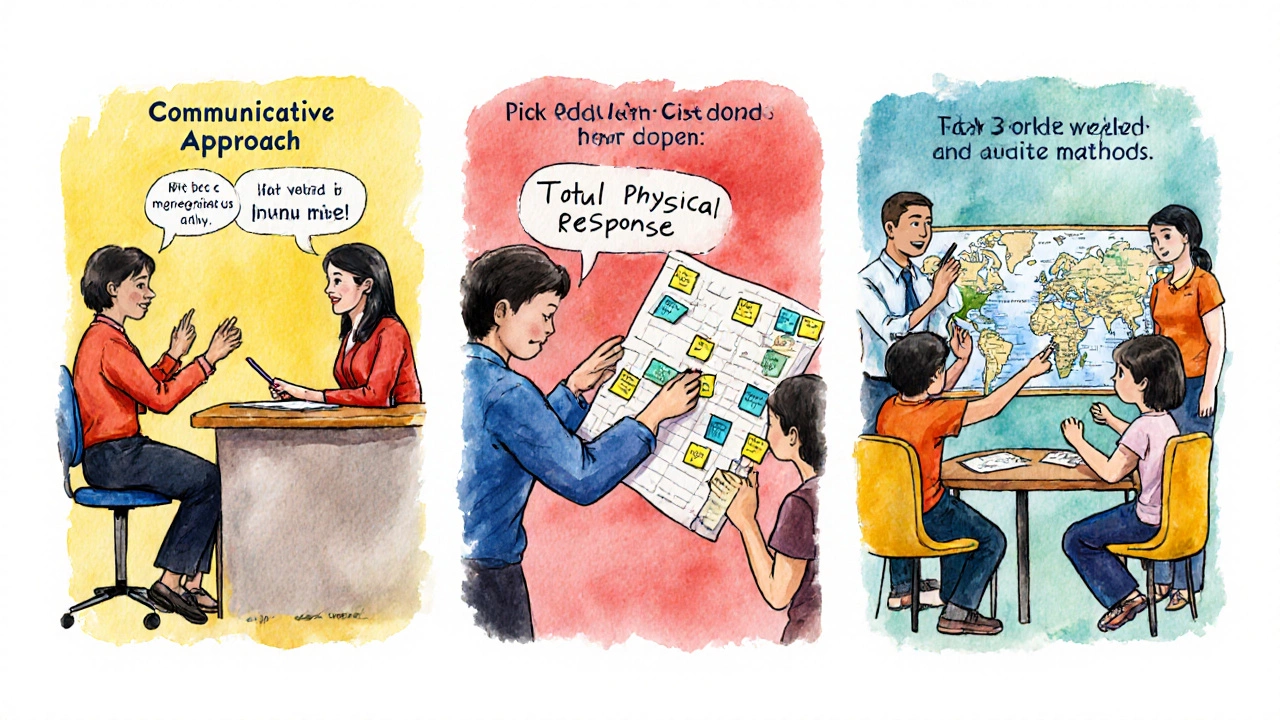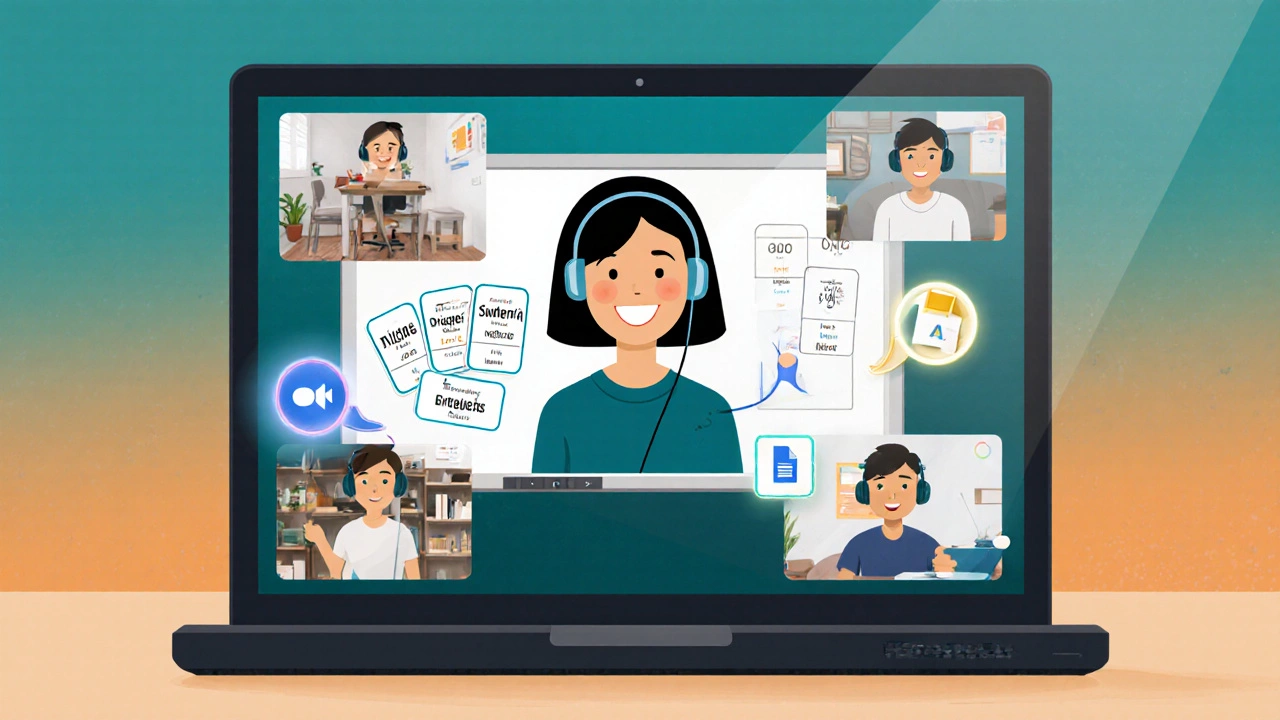CEFR Progress Calculator
Estimated Progress
Based on your input:
Key Takeaways
- Adults learn best when lessons are relevant, interactive, and respect their life experience.
- Blend speaking, listening, reading, and writing, but give speaking the spotlight.
- Use proven methods like the Communicative Approach, Total Physical Response, and Task‑Based Learning.
- Set realistic goals using the CEFR framework (A1‑A2 for beginners).
- Leverage technology (Zoom, Google Meet) to create a supportive online environment.
Teaching English to adult beginners can feel like solving a puzzle. You have learners who may be juggling work, family, and confidence issues, yet they’re eager to speak like a native. The good news? Adults bring a wealth of life experience, which you can turn into powerful learning material. Below is a step‑by‑step guide that shows exactly how to design, run, and improve an English‑speaking course for adult newcomers.
Teaching English to Adult Beginners is a specialized branch of ESL instruction that focuses on learners with little or no prior exposure to English, typically aged 18 and above. The goal is to move students from zero baseline to functional conversation within a few months, using methods that respect adult learning principles.
1. Understand Adult Learning Theory
Before you pick a textbook, remember that adults learn differently from kids. Adult Learning Theory (also called andragogy) emphasizes self‑directed learning, relevance to real life, and immediate application. Ask yourself:
- What problems do my learners face at work or in daily life?
- How can English help them solve those problems right now?
- What prior knowledge can I tap into?
When you align lessons with these questions, motivation skyrockets.
2. Set Clear, Measurable Goals Using CEFR
The Common European Framework of Reference for Languages (CEFR) offers a globally recognized scale from A1 (beginner) to C2 (mastery). For adult beginners, aim for A1‑A2 milestones:
- Listening: Understand simple greetings and basic instructions.
- Speaking: Introduce yourself, ask for directions, order food.
- Reading: Recognize familiar names, signs, and short emails.
- Writing: Fill out a form, write a short note.
Write these goals on the board, share them in the syllabus, and revisit them each week.
3. Choose the Right Teaching Method(s)
No single method works for every adult learner. Here’s a quick comparison of four proven approaches:
| Method | Core Idea | Strengths for Adults | Typical Activities |
|---|---|---|---|
| Communicative Approach | Language is learned through real communication. | Encourages immediate use; mirrors workplace interactions. | Role‑plays, information‑gap tasks, interview simulations. |
| Total Physical Response (TPR) | Learners respond physically to spoken commands. | Great for memory; lowers anxiety for shy adults. | “Pick up the pen,” “Walk to the window,” command‑driven games. |
| Task‑Based Learning | Focus on completing meaningful tasks. | Provides clear purpose; aligns with job‑related goals. | Planning a trip, creating a budget, solving a customer complaint. |
| Grammar‑Translation | Translate sentences to understand structure. | Useful for learners who need explicit rules. | Reading short passages, filling in blanks, sentence reconstruction. |
Mix and match: start with TPR to warm up, then shift into Communicative or Task‑Based activities as confidence builds.

4. Build a Speaking‑Centric Classroom
Adult beginners often fear speaking because they think they’ll sound dumb. Flip that script by making speaking the default activity, not the exception.
- Warm‑up circles: Each person says one sentence about their morning routine.
- Information‑gap pairs: One student has a schedule, the other asks for details (“What time is the meeting?”).
- Pronunciation drills: Focus on tricky sounds like /θ/ and /ð/. Use minimal pairs (thin / fin, then / den).
Keep error correction gentle. Offer a short “correction window” after each activity rather than interrupting mid‑sentence.
5. Use Real‑World Materials
Adults need content that mirrors what they’ll encounter outside the classroom.
- Vending‑machine instructions, public‑transport timetables, simple email templates.
- Short news clips from BBC Learning English or Voice of America.
- Job‑related jargon for specific sectors (e.g., “invoice,” “client,” “shift”).
When learners see immediate relevance, they are more likely to practice on their own.
6. Leverage Technology Wisely
Virtual platforms are no longer a luxury; they’re a necessity for many adult learners who can’t attend a brick‑and‑mortar class.
Zoom offers breakout rooms for pair work, screen‑sharing for documents, and a chat window for quick vocab checks. Combine it with Google Docs for collaborative writing tasks and Quizlet for flashcard‑based vocabulary drills.
Set clear netiquette rules: mute when not speaking, raise hand virtually, and keep cameras on for accountability.
7. Provide Structured Homework that Reinforces Speaking
Homework for adults should be short, purposeful, and tied to the next class.
- Record a 30‑second self‑introduction and upload it to a shared folder.
- Use a language‑exchange app (e.g., Tandem) to have a 5‑minute voice chat with a native speaker.
- Complete a “fill‑in‑the‑blank” dialogue worksheet, then practice it aloud.
Review recordings in the next session, highlighting two strengths and one area to improve.

8. Assess Progress without Stalling Motivation
Traditional exams can intimidate adult beginners. Instead, use formative checks:
- Mini‑conversations: 2‑minute partner talks scored on fluency and accuracy.
- Self‑assessment checklists: Learners mark if they can do tasks like “order coffee in English.”
- Portfolio: Collect audio clips, written notes, and completed worksheets to show growth over time.
Celebrate small wins publicly - a quick round of applause or a digital badge.
9. Tackle Common Pitfalls
Even experienced teachers hit snags. Here are three frequent problems and quick fixes:
- Students rely on translation. Introduce “think in English” moments, like naming objects in the room without using their mother tongue.
- Pronunciation stalls. Use visual mouth diagrams and short mirror exercises. Record and compare.
- Class feels too academic. Sprinkle humor, cultural anecdotes, or short games every 20 minutes.
10. Keep Evolving Your Course
Gather feedback after each module. Ask simple questions: “What helped you speak more?” and “What confused you?” Adjust the mix of methods based on answers. Over time you’ll discover the perfect balance for your particular group.
Frequently Asked Questions
How many weeks does it take for an adult beginner to reach A1 level?
With 3‑hour classes twice a week and daily 15‑minute self‑practice, most learners hit A1 in 8‑10 weeks. Faster progress is possible if they immerse themselves in English outside class.
Can I teach adult beginners with no formal teaching certificate?
Yes, especially if you have strong English proficiency and a passion for adult education. Many community centers accept volunteers who follow proven methods like the Communicative Approach.
What online tools work best for speaking practice?
Zoom breakout rooms, Google Meet, and language‑exchange apps such as Tandem or HelloTalk let learners have real‑time conversations. Pair them with recording tools like Vocaroo for self‑review.
How do I keep shy adults from staying silent?
Start with low‑stakes activities: command‑based TPR, picture description, or ‘two‑minute talk’ where each person shares a favorite hobby. Praise effort, not perfection.
Should I teach grammar explicitly?
A light touch works best. Introduce one rule, then embed it in a communicative task. Adults appreciate knowing why a structure exists, but they hate endless drills.
Teaching English to adult beginners isn’t a one‑size‑fits‑all project. By respecting adult learning theory, using the CEFR to set clear milestones, mixing proven methods, and leveraging technology, you’ll see learners go from hesitant silence to confident conversation. Keep the feedback loop open, adjust your approach, and watch the transformation unfold.
